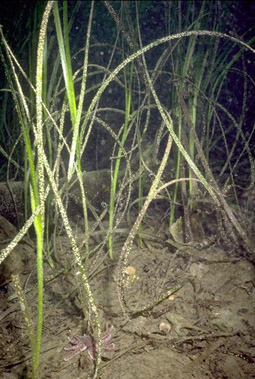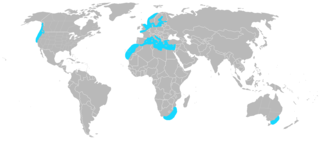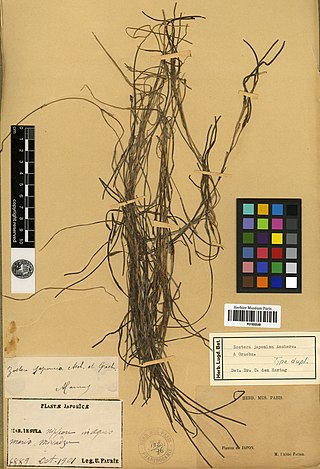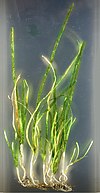
Seagrasses are the only flowering plants which grow in marine environments. There are about 60 species of fully marine seagrasses which belong to four families, all in the order Alismatales. Seagrasses evolved from terrestrial plants which recolonised the ocean 70 to 100 million years ago.

Coos Bay is an estuary where the Coos River enters the Pacific Ocean, the estuary is approximately 12 miles long and up to two miles wide. It is the largest estuary completely within Oregon state lines. The Coos Bay watershed covers an area of about 600 square miles and is located in northern Coos County, Oregon, in the United States. The Coos River, which begins in the Oregon Coast Range, enters the bay from the east. From Coos River, the bay forms a sharp loop northward before arching back to the south and out to the Pacific Ocean. Haynes Inlet enters the top of this loop. South Slough branches off from the bay directly before its entrance into the Pacific Ocean. The bay was formed when sea levels rose over 20,000 years ago at the end of the Last Glacial Maximum, flooding the mouth of the Coos River. Coos Bay is Oregon's most important coastal industrial center and international shipping port, with close ties to San Francisco, the Columbia River, Puget Sound and other major ports of the Pacific rim.

Zostera is a small genus of widely distributed seagrasses, commonly called marine eelgrass, or simply seagrass or eelgrass, and also known as seaweed by some fishermen and recreational boaters including yachtsmen. The genus Zostera contains 15 species.

A seagrass meadow or seagrass bed is an underwater ecosystem formed by seagrasses. Seagrasses are marine (saltwater) plants found in shallow coastal waters and in the brackish waters of estuaries. Seagrasses are flowering plants with stems and long green, grass-like leaves. They produce seeds and pollen and have roots and rhizomes which anchor them in seafloor sand.

Lottia is a genus of sea snails, specifically true limpets, marine gastropod mollusks in the subfamily Lottiinae of the family Lottiidae, one of the families of true limpets.

The estuarine pipefish or river pipefish is a species of fish in the family Syngnathidae. It is endemic to South Africa and has been sporadically recorded in the estuarine portions of the Kariega, Kasouga, Bushmans, East Kleinemonde and West Kleinemonde rivers. It can be readily distinguished from another southern African pipefish with which it shares its habitat, S. temminckii, by its much shorter snout. The estuarine pipefish is most commonly found in beds of the eelgrass Zostera capensis.
† Lottia edmitchelli was a species of limpet in the family Lottiidae. It was native to the coast of Southern California, where it may have been endemic. Specimens are known from San Nicolas Island, one of the Channel Islands of California, and from San Pedro in the city of Los Angeles.

Sagenista is a group of heterokonts containing the labyrinthulids and Eogyrea, a class of yet uncultured protists. Originally, it contained the Labyrinthulids and bicosoecids. The bicosoecids have been removed, and Eogyrea were added, in order to make the group monophyletic.
The genus Labyrinthula is part of the protist group Labyrinthulomycetes and contains thirteen species. The major feature of this genus is the formation of an ectoplasmic net secreted by specialized organelles called bothrosomes which surrounds the colony, which is also used by Labyrinthula for moving. The protist reproduces by zoosporulation as it sets some flagellated spores free from a sporangium. One of the flagella of the zoospores has stiff tripartite hairs (mastigonemes) - the defining characteristic of the stramenopiles.

Zostera marina is a flowering vascular plant species as one of many kinds of seagrass, with this species known primarily by the English name of eelgrass with seawrack much less used, and refers to the plant after breaking loose from the submerged wetland soil, and drifting free with ocean current and waves to a coast seashore. It is a saline soft-sediment submerged plant native to marine environments on the coastlines of northern latitudes from subtropical to subpolar regions of North America and Eurasia.

Zostera noltii is a species of seagrass known by the common name dwarf eelgrass. It is found in shallow coastal waters in north western Europe, the Mediterranean Sea, Black Sea, Caspian Sea and Aral Sea and on islands in the Atlantic off the coast of northwest Africa. It is an important part of the intertidal and shallow subtidal ecosystems of estuaries, bays and lagoons.

Plasmodiophora bicaudata is a marine pathogen, an obligate parasite of seagrass of the genus Zostera and the causal agent of wasting disease in the genus. These marine plants grow in fine sediment in shallow seas and the pathogen seems to have a worldwide distribution.
Zostera novazelandica Setchell is a species of seagrass in the family Zosteraceae found on the shores of New Zealand. It is regarded as a distinct species by some authors but considered as a synonym of Zostera muelleri Irmisch ex Ascherson by others. The Maori names for Zostera novazelandica are karepō, nana, rehia, and rimurehia.

Zostera japonica is a species of aquatic plant in the Zosteraceae family. It is referred to by the common names dwarf eelgrass or Japanese eelgrass, and is native to the seacoast of eastern Asia from Russia to Vietnam, and introduced to the western coast of North America. It is found in the intertidal zone and the shallow subtidal, and grows on sandy, muddy and silty substrates.

Zostera muelleri is a southern hemisphere temperate species of seagrass native to the seacoasts of South Australia, Victoria and Tasmania. and New Zealand. Today, Zostera muelleri can be found in regions of Australia, New Zealand, and Papua New Guinea, as well as areas of the eastern Indian Ocean, and the southwest and western central Pacific Ocean. Zostera muelleri is a marine angiosperm, and is commonly referred to as eelgrass or garweed. It is a fast growing and readily colonizing species that serves as a feeding ground for wading birds and aquatic animals, and a breeding ground for juvenile fish and shrimp species.

Biodiversity loss happens when plant or animal species disappear completely from Earth (extinction) or when there is a decrease or disappearance of species in a specific area. Biodiversity loss means that there is a reduction in biological diversity in a given area. The decrease can be temporary or permanent. It is temporary if the damage that led to the loss is reversible in time, for example through ecological restoration. If this is not possible, then the decrease is permanent. The cause of most of the biodiversity loss is, generally speaking, human activities that push the planetary boundaries too far. These activities include habitat destruction and land use intensification. Further problem areas are air and water pollution, over-exploitation, invasive species and climate change.

Arcuatula senhousia, commonly known as the Asian date mussel, Asian mussel or bag mussel, is a small saltwater mussel, a marine bivalve mollusk species in the family Mytilidae, the mussels. Other common names for this species include: the Japanese mussel, Senhouse's mussel, the green mussel, and the green bagmussel. It is harvested for human consumption in China.
Polly A. Penhale is an American biologist and Environmental Officer at the National Science Foundation. She is a leading figure in Antarctic research, and has been recognized for contributions to research, policy, and environmental conservation. Penhale Peak in Antarctica is named for her.

Lottia instabilis is a species of sea snail, a true limpet, a marine gastropod mollusk in the family Lottiidae. Common names include the unstable limpet, the unstable seaweed limpet and the rocking chair limpet. It is native to the northern Pacific Ocean where it feeds on kelp in the intertidal zone and the shallow sub-littoral zone.

Lottia asmi, commonly known as the black limpet, is a species of sea snail, a marine gastropod mollusk in the family Lottiidae. It is found in shallow water in the eastern Pacific Ocean, usually in the intertidal zone.
















